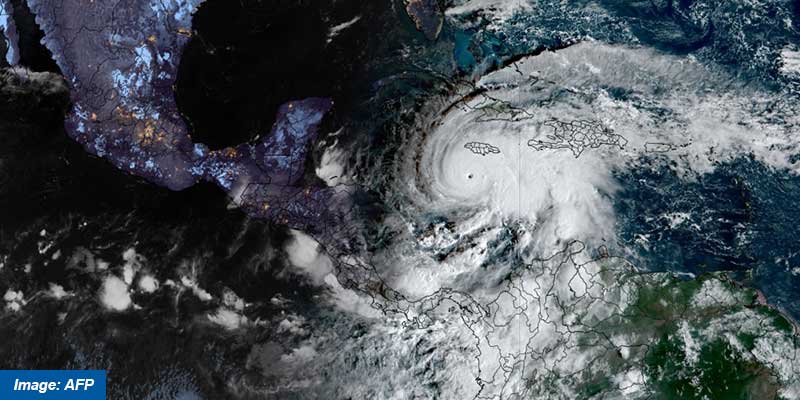- World
- Oct 27
What is a Category 5 storm?
• Hurricane Melissa intensified to Category 5 strength as it neared Jamaica on October 27, where forecasters said it would unleash catastrophic flooding, multiple landslides and extensive infrastructure damage.
• Prime Minister Andrew Holness warned it could be Jamaica’s most destructive storm on record.
• Category 5 is the highest on the Saffir-Simpson scale with sustained winds exceeding 250 kph.
• The US National Hurricane Center (NHC) said it could wreak devastation on the scale of historic hurricanes including ‘Maria’ in 2017 or Katrina in 2005.
What is the difference between a typhoon, hurricane and cyclone?
• The terms hurricane and typhoon are regional names for tropical cyclones.
• All tropical cyclones are alike in that they draw heat from warm water at the ocean’s surface to power horizontal, rotating wind.
• Although similar in size, tropical cyclones have a different energy source than synoptic cyclones, which are storm systems that draw their energy from weather fronts and jet streams.
• In the North Atlantic, central North Pacific, and eastern North Pacific, the term hurricane is used.
• The same type of disturbance in the Northwest Pacific is called a typhoon.
• Meanwhile, in the South Pacific and Indian Ocean, the generic term tropical cyclone is used.
• The ingredients for tropical cyclones include a pre-existing weather disturbance, warm tropical oceans, moisture, and relatively light winds. If the right conditions persist long enough, they can combine to produce the violent winds, large waves, torrential rains, and floods we associate with this phenomenon.
The Saffir-Simpson Scale
• In the early 1970s, a classification system was designed to quantify the level of damage and flooding expected from a hurricane.
• This system was conceived by Herbert Saffir, a consulting engineer, and Robert Simpson, then the director of the National Hurricane Center.
• Using a mix of structural engineering and meteorology, they constructed the Saffir-Simpson Hurricane Intensity Scale, or simply, the Saffir-Simpson Scale.
• Initially, Saffir and Simpson created the scale based solely on wind speed. Later, Simpson added storm-surge levels. Low atmospheric pressure is also associated with hurricanes.
• Consisting of 5 categories (1 being the weakest and 5 being the strongest), the scale corresponds to a hurricane’s central pressure, maximum sustained winds, and storm surge.
• Sustained wind speeds are the determining factor in the scale, as storm surge values are highly dependent on the slope of the continental shelf in the landfall region.
1) Category 1: Winds at 74-95 mph (119-153 kph)
Damage: Minimal. No real damage to buildings. Damage to unanchored mobile homes. Some damage to poorly constructed signs. Some coastal flooding and minor pier damage.
2) Category 2: Winds at 96-110 mph (154-177 kph)
Damage: Moderate. Some damage to building roofs, doors, and windows. Considerable damage to mobile homes. Damage to piers from flooding. Small craft in unprotected moorings may break their moorings. Some trees blown down. Evacuation of some shoreline residences and low-lying areas required.
3) Category 3: Winds at 111-130 mph (178-209 kph)
Damage: Extensive. Some structural damage to small residences and utility buildings. Large trees blown down. Mobile homes and poorly built signs destroyed. Flooding near the coast destroys smaller structures with larger structures damaged by floating debris. Terrain may be flooded well inland. Evacuation of low-lying residences within several blocks of the shoreline may be required.
4) Category 4: Winds at 131-155 mph (210-249 kph)
Damage: Extreme. More extensive failure on non-bearing, exterior walls with some complete roof structure failure on small residences. Major erosion of beach areas. Terrain may be flooded well inland. Massive evacuation of residential areas as far inland as 10 km may be required.
5) Category 5: Winds greater than 155 mph (249 kph)
Damage: Catastrophic. Complete roof failure on many residences and industrial buildings. Some complete building failures with small utility buildings blown over or away. Flooding causes major damage to lower floors of all structures near the shoreline. Massive evacuation of residential areas on low ground within 8 to 16 km of the shoreline may be required.

